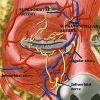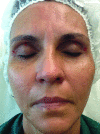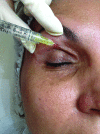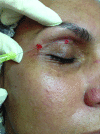Comprehensive Treatment of Periorbital Region with Hyaluronic Acid
- PMID: 26155325
- PMCID: PMC4479367
Comprehensive Treatment of Periorbital Region with Hyaluronic Acid
Abstract
The periorbital subunit is one of the first facial regions to show signs of aging, primarily due to volume depletion of the soft tissue and bony resorption. Surgical and office-based nonsurgical procedures form an important basis for periorbital rejuvenation. It is important to make a detailed clinical evaluation of the patient to indicate the most appropriate procedure to be performed. With the objective of showing a nonsurgical procedure for the rejuvenation of the periorbital area, the authors describe a technique of applying fillers in the upper and lower periorbital regions, paying attention to the anatomy of this facial region and the type of product to be used besides the expected results of the procedure and its possible adverse effects and complications. The nonsurgical rejuvenation of the periorbicular region with hyaluronic acid is a new and innovative technique. In the opinion of the authors, it is a great aesthetic impact area and consequently brings high satisfaction to patients.
Figures






References
-
- Kahn D, Shaw R. Aging of the bony orbit: a three dimensional computed tomographic study. Aesthetic Surg J. 2008;28:258–264. - PubMed
-
- Liew S, Nguyen DQ. Nonsurgical volumetric upper periorbital rejuvenation: a plastic surgeon’s perspective. Aesth Plast Surg. 2011;35:319–325. - PubMed
-
- Fagien S. Advanced rejuvenative upper blepharoplasty enhancing aesthetics of the upper periorbita. Plast Reconstr Surg. 2002;110:278–291. - PubMed
-
- Kranedonk S, Obagi S. Autologous fat transfer for periorbital rejuvenation: indications, technique, and complications. Dermatol Surg. 2007;35:572–578. - PubMed
-
- Moran ML. Office-based periorbital rejuvenation. Facial Plast Surg. 2013;29:58–63. - PubMed
Publication types
LinkOut - more resources
Full Text Sources
